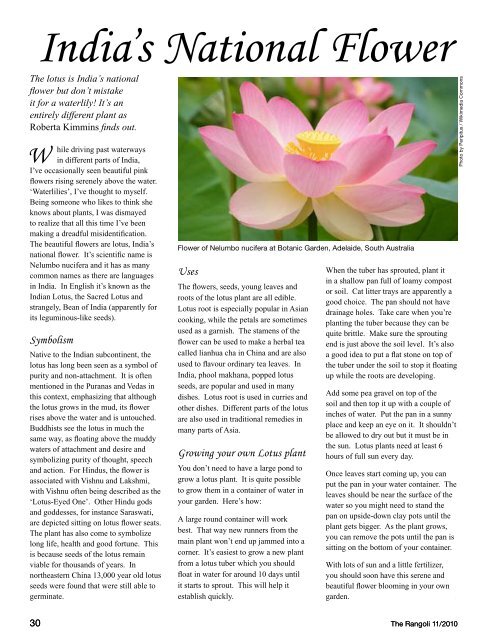Diwali: Festival of Lights India Night Indian Dance - The Overseas ...
Diwali: Festival of Lights India Night Indian Dance - The Overseas ...
Diwali: Festival of Lights India Night Indian Dance - The Overseas ...
Create successful ePaper yourself
Turn your PDF publications into a flip-book with our unique Google optimized e-Paper software.
<strong>India</strong>’s National Flower<strong>The</strong> lotus is <strong>India</strong>’s nationalflower but don’t mistakeit for a waterlily! It’s anentirely different plant asRoberta Kimmins finds out.While driving past waterwaysin different parts <strong>of</strong> <strong>India</strong>,I’ve occasionally seen beautiful pinkflowers rising serenely above the water.‘Waterlilies’, I’ve thought to myself.Being someone who likes to think sheknows about plants, I was dismayedto realize that all this time I’ve beenmaking a dreadful misidentification.<strong>The</strong> beautiful flowers are lotus, <strong>India</strong>’snational flower. It’s scientific name isNelumbo nucifera and it has as manycommon names as there are languagesin <strong>India</strong>. In English it’s known as the<strong>India</strong>n Lotus, the Sacred Lotus andstrangely, Bean <strong>of</strong> <strong>India</strong> (apparently forits leguminous-like seeds).SymbolismNative to the <strong>India</strong>n subcontinent, thelotus has long been seen as a symbol <strong>of</strong>purity and non-attachment. It is <strong>of</strong>tenmentioned in the Puranas and Vedas inthis context, emphasizing that althoughthe lotus grows in the mud, its flowerrises above the water and is untouched.Buddhists see the lotus in much thesame way, as floating above the muddywaters <strong>of</strong> attachment and desire andsymbolizing purity <strong>of</strong> thought, speechand action. For Hindus, the flower isassociated with Vishnu and Lakshmi,with Vishnu <strong>of</strong>ten being described as the‘Lotus-Eyed One’. Other Hindu godsand goddesses, for instance Saraswati,are depicted sitting on lotus flower seats.<strong>The</strong> plant has also come to symbolizelong life, health and good fortune. Thisis because seeds <strong>of</strong> the lotus remainviable for thousands <strong>of</strong> years. Innortheastern China 13,000 year old lotusseeds were found that were still able togerminate.Flower <strong>of</strong> Nelumbo nucifera at Botanic Garden, Adelaide, South AustraliaUses<strong>The</strong> flowers, seeds, young leaves androots <strong>of</strong> the lotus plant are all edible.Lotus root is especially popular in Asiancooking, while the petals are sometimesused as a garnish. <strong>The</strong> stamens <strong>of</strong> theflower can be used to make a herbal teacalled lianhua cha in China and are alsoused to flavour ordinary tea leaves. In<strong>India</strong>, phool makhana, popped lotusseeds, are popular and used in manydishes. Lotus root is used in curries andother dishes. Different parts <strong>of</strong> the lotusare also used in traditional remedies inmany parts <strong>of</strong> Asia.Growing your own Lotus plantYou don’t need to have a large pond togrow a lotus plant. It is quite possibleto grow them in a container <strong>of</strong> water inyour garden. Here’s how:A large round container will workbest. That way new runners from themain plant won’t end up jammed into acorner. It’s easiest to grow a new plantfrom a lotus tuber which you shouldfloat in water for around 10 days untilit starts to sprout. This will help itestablish quickly.When the tuber has sprouted, plant itin a shallow pan full <strong>of</strong> loamy compostor soil. Cat litter trays are apparently agood choice. <strong>The</strong> pan should not havedrainage holes. Take care when you’replanting the tuber because they can bequite brittle. Make sure the sproutingend is just above the soil level. It’s alsoa good idea to put a flat stone on top <strong>of</strong>the tuber under the soil to stop it floatingup while the roots are developing.Add some pea gravel on top <strong>of</strong> thesoil and then top it up with a couple <strong>of</strong>inches <strong>of</strong> water. Put the pan in a sunnyplace and keep an eye on it. It shouldn’tbe allowed to dry out but it must be inthe sun. Lotus plants need at least 6hours <strong>of</strong> full sun every day.Once leaves start coming up, you canput the pan in your water container. <strong>The</strong>leaves should be near the surface <strong>of</strong> thewater so you might need to stand thepan on upside-down clay pots until theplant gets bigger. As the plant grows,you can remove the pots until the pan issitting on the bottom <strong>of</strong> your container.With lots <strong>of</strong> sun and a little fertilizer,you should soon have this serene andbeautiful flower blooming in your owngarden.Photo by Peripitus / Wikimedia Commons30 <strong>The</strong> Rangoli 11/2010



